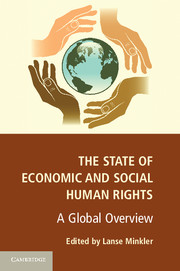Book contents
- Frontmatter
- Contents
- Contributors
- Acknowledgments
- 1 Introduction: Why Economic and Social Human Rights?
- I CORE RIGHTS
- II NONDISCRIMINATION
- 7 The Rights of the Child to an Adequate Standard of Living: Applying International Standards to the U.S. Case
- 8 Achieving Women's Economic Rights, in Policy and in Practice
- 9 Statelessness and Economic and Social Rights
- III META
- Index
- References
8 - Achieving Women's Economic Rights, in Policy and in Practice
Published online by Cambridge University Press: 05 February 2013
- Frontmatter
- Contents
- Contributors
- Acknowledgments
- 1 Introduction: Why Economic and Social Human Rights?
- I CORE RIGHTS
- II NONDISCRIMINATION
- 7 The Rights of the Child to an Adequate Standard of Living: Applying International Standards to the U.S. Case
- 8 Achieving Women's Economic Rights, in Policy and in Practice
- 9 Statelessness and Economic and Social Rights
- III META
- Index
- References
Summary
Introduction
In March 2010, representatives to the Commission on the Status of Women gathered in New York to assess the progress that has been made in the achievement of global women's rights. This meeting marked the 15th anniversary of the Fourth World Conference on Women, held in Beijing in 1995. Although the regional reports compiled for this fifteen-year review showed notable progress in some areas, including the development of domestic legislation, there remained a considerable gap in many countries between the de jure and de facto status of women. This was particularly evident in the categories of poverty alleviation and women's economic empowerment. A lack of disaggregated data, combined with context-specific barriers as well as the historical prioritization of civil and political rights, has hindered the process of translating legal respect for women's economic rights into their fulfillment. Through considering the case study of women's employment protections and property rights in Ghana, this chapter illustrates that it is not simply a lack of legal protections that results in rights being left unfulfilled. Local information about the ways that individuals engage with these laws on an everyday basis is essential in implementing human rights-related policies. Legal reforms must be coupled with programs that account for the social, political, and cultural conditions that lead to barriers in rights attainment.
Women's Human Rights: A Brief History
The current state of women's economic rights has its roots in the history of the women's rights movement. Many cite The First World Conference on Women, held in Mexico in 1975, as a starting point for the entrance of women's issues into the international intergovernmental agenda (Friedman 1995). Notably, this conference also marked the start of the United Nations (UN) Decade for Women. Although women had been involved in the UN since its inception, human rights documents had mainly dealt with rights through gender-neutral language. Critics soon acknowledged that this philosophy could, however, be seen as a “double-edged instrument if it is used to punish women for failing to conform to the conventional norms expected of men” (Kaufman and Lindquist 1995, 121).
- Type
- Chapter
- Information
- The State of Economic and Social Human RightsA Global Overview, pp. 204 - 220Publisher: Cambridge University PressPrint publication year: 2013

